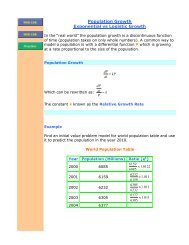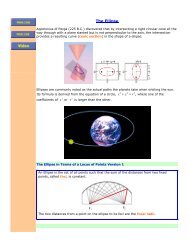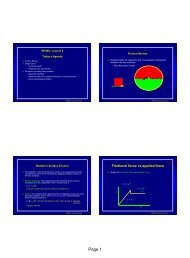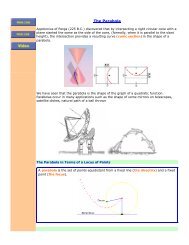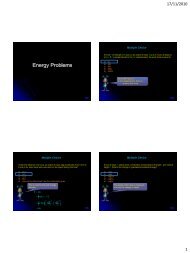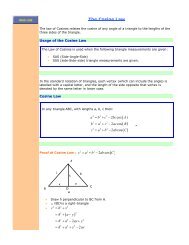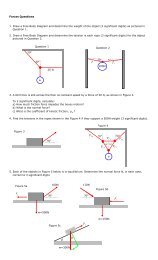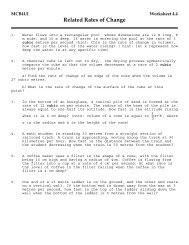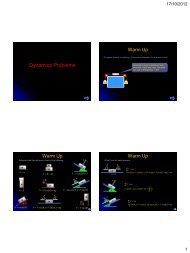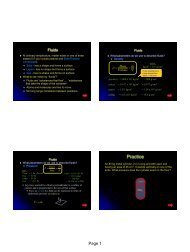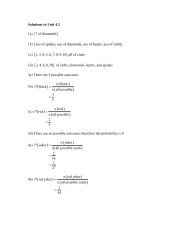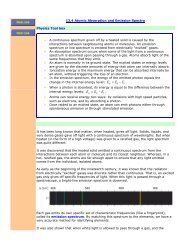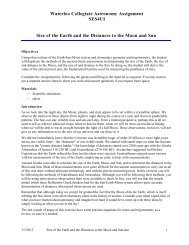Fluid Dynamics - The Burns Home Page
Fluid Dynamics - The Burns Home Page
Fluid Dynamics - The Burns Home Page
- No tags were found...
Create successful ePaper yourself
Turn your PDF publications into a flip-book with our unique Google optimized e-Paper software.
25/08/2010Question 8A water pump is attached to the left end of a horizontal pipe thatconsists of a rigid section and a flexible second section that canhave its cross-sectional area adjusted. A pool needs to be filled withthe output of the flexible section. Which of the following will increasethe rate at which the pool will fill?I. Increase the pump pressureII. Decrease the cross-sectional area of the second sectionIII. Increase the cross-sectional area of the second sectionA) I onlyB) II onlyC) III onlyD) I and II onlyE) I and III onlyFirst Bernoulli’s Equation tells us that by increasing thepressure at the input will result with an increase of the velocityat the output for any cross section. <strong>The</strong> continuity equation tellsus that changing the cross-sectional area will not affect theamount that flows into the pool.Question 9An ideal fluid flows through a pipe that runs up an incline andgradually rises to a height H. <strong>The</strong> cross sectional area of the pipe isuniform. Compared with the flow at the bottom of the incline, the flowat the top is:A) Moving slower at lower pressureB) Moving slower at higher pressureC) Moving at the same speed at lower pressureD) Moving at the same rate at higher pressureE) Moving faster at lower pressureSince the area did not change, the continuity equation impliesthat the fluid velocity is the same. Bernoulli’s Equation tells usthat the pressure at height H must be lessA v A v1 1 2 2v v1 21 2 1vbottom Pbottom vtop 2 2 Ptop gH2P P gHbottomtoptopP P gHbottomQuestion 10A beaker of water sits on an electric scale with an initial reading of30 N. A mass with 3 times the density of water hangs from a springscale with an initial reading of 6 N. Still attached to the spring scale,the mass is completely immersed in the water. <strong>The</strong> reading on thetwo scales (in electric, spring order) will be:A) 30 N, 2 NB) 32 N, 6 NC) 36 N, 2 ND) 32 N, 4 NE) 36 N, 4 NSince the density is 3 times as great as water, the object willexperience a buoyant force of one-third its weight, or 2 N. <strong>The</strong>spring scale will then read 6 – 2 = 4 N. <strong>The</strong> reaction to thebuoyant force acts on the water and eventually the electronicscale, producing an extra downward force of 2 N. <strong>The</strong> scalethen reads 32 N.Question 11<strong>The</strong> water tower in the drawing is drained by a pipe that extends tothe ground. <strong>The</strong> amount of water in the top of the spherical portion ofthe tank is significantly greater than the amount of water in thesupporting column (density of water 1000 kg/m 3 ) :A) What is the absolute pressure at the position of the valve if the Pvalve is closed, assuming that the top surface of the water atpoint P is at atmospheric pressure (10 5 N/m 2 ) ?B) Now the valve is opened; thus, the pressure at the valve isforced to be atmospheric pressure. What is the speed of thewater past the valve?C) Assuming that the radius of the circular valve opening is 10 cm,find the volume flow rate out of the valve.15 mD) Considering that virtually all of the water is originally contained inthe top spherical portion of the tank, estimate the initial volumeof the water contained by the water tower.E) Estimate how long it would take to drain the tank completelyusing this single valve.valve3
25/08/2010Question 11 Solution<strong>The</strong> water tower in the drawing is drained by a pipe that extends to the ground. <strong>The</strong>amount of water in the top of the spherical portion of the tank is significantly greater thanthe amount of water in the supporting column (density of water 1000 kg/m 3 )Question 11 Solution<strong>The</strong> water tower in the drawing is drained by a pipe that extends to the ground. <strong>The</strong>amount of water in the top of the spherical portion of the tank is significantly greater thanthe amount of water in the supporting column (density of water 1000 kg/m 3 )A) What is the absolute pressure at the position of the valve if the valve is closed,assuming that the top surface of the water at point P is at atmospheric pressure(10 5 N/m 2 ? )B) Now the valve is opened; thus, the pressure at the valve is forced to beatmospheric pressure. What is the speed of the water past the valve?C) Assuming that the radius of the circular valve opening is 10 cm, find the volumeflow rate out of the valve.D) Considering that virtually all of the water is originally contained in the top sphericalportion of the tank, estimate the initial volume of the water contained by the watertower.E) Estimate how long it would take to drain the tank completely using this single valve.P Pogh N kg N m m kg N 2470002m5 N2.5102m51 10 1000 9.8 152 3mvalveP15 mA) What is the absolute pressure at the position of the valve if the valve is closed,assuming that the top surface of the water at point P is at atmospheric pressure(10 5 N/m 2 )B) Now the valve is opened; thus, the pressure at the valve is forced to beatmospheric pressure. What is the speed of the water past the valve?C) Assuming that the radius of the circular valve opening is 10 cm, find the volumeflow rate out of the valve.D) Considering that virtually all of the water is originally contained in the top sphericalportion of the tank, estimate the initial volume of the water contained by the watertower.E) Estimate how long it would take to drain the tank completely using this single valve.1 1P gy v P gy v2 21 2 1 2gy1 v1 gy2 v22 21 2gy1 v222 21 1 1 2 2 2Pressure at P is thesame as the pressureat the valve.Velocity at P is 0, setvalve to be our zero point,so pgy 2 =0valveP15 mQuestion 11 Solution<strong>The</strong> water tower in the drawing is drained by a pipe that extends to the ground. <strong>The</strong>amount of water in the top of the spherical portion of the tank is significantly greater thanthe amount of water in the supporting column (density of water 1000 kg/m 3 )A) What is the absolute pressure at the position of the valve if the valve is closed,assuming that the top surface of the water at point P is at atmospheric pressure(10 5 N/m 2 )B) Now the valve is opened; thus, the pressure at the valve is forced to beatmospheric pressure. What is the speed of the water past the valve?C) Assuming that the radius of the circular valve opening is 10 cm, find the volumeflow rate out of the valve.D) Considering that virtually all of the water is originally contained in the top sphericalportion of the tank, estimate the initial volume of the water contained by the watertower.E) Estimate how long it would take to drain the tank completely using this single valve.1gy v221 21 2gy1 v22v 2gy2 1 m 29.8 2 15m s m17sThis isTorricelli’s LawvalveP15 mQuestion 11 Solution<strong>The</strong> water tower in the drawing is drained by a pipe that extends to the ground. <strong>The</strong>amount of water in the top of the spherical portion of the tank is significantly greater thanthe amount of water in the supporting column (density of water 1000 kg/m 3 )A) What is the absolute pressure at the position of the valve if the valve is closed,assuming that the top surface of the water at point P is at atmospheric pressure(10 5 N/m 2 )B) Now the valve is opened; thus, the pressure at the valve is forced to beatmospheric pressure. What is the speed of the water past the valve?C) Assuming that the radius of the circular valve opening is 10 cm, find the volumeflow rate out of the valve.D) Considering that virtually all of the water is originally contained in the top sphericalportion of the tank, estimate the initial volume of the water contained by the watertower.E) Estimate how long it would take to drain the tank completely using this single valve.Flow rate Av2Flow rate r v2 m 0.1m 17 s 2 m0.314m17s3m 0.53svalveP15 m4
25/08/2010Question 11 SolutionQuestion 11 Solution<strong>The</strong> water tower in the drawing is drained by a pipe that extends to the ground. <strong>The</strong>amount of water in the top of the spherical portion of the tank is significantly greater thanthe amount of water in the supporting column (density of water 1000 kg/m 3 )<strong>The</strong> water tower in the drawing is drained by a pipe that extends to the ground. <strong>The</strong>amount of water in the top of the spherical portion of the tank is significantly greater thanthe amount of water in the supporting column (density of water 1000 kg/m 3 )A) What is the absolute pressure at the position of the valve if the valve is closed,assuming that the top surface of the water at point P is at atmospheric pressure(10 5 N/m 2 )B) Now the valve is opened; thus, the pressure at the valve is forced to beatmospheric pressure. What is the speed of the water past the valve?C) Assuming that the radius of the circular valve opening is 10 cm, find the volumeflow rate out of the valve.D) Considering that virtually all of the water is originally contained in the top sphericalportion of the tank, estimate the initial volume of the water contained by the watertower.E) Estimate how long it would take to drain the tank completely using this single valve.PA) What is the absolute pressure at the position of the valve if the valve is closed,assuming that the top surface of the water at point P is at atmospheric pressure(10 5 N/m 2 )B) Now the valve is opened; thus, the pressure at the valve is forced to beatmospheric pressure. What is the speed of the water past the valve?C) Assuming that the radius of the circular valve opening is 10 cm, find the volumeflow rate out of the valve.D) Considering that virtually all of the water is originally contained in the top sphericalportion of the tank, estimate the initial volume of the water contained by the watertower.E) Estimate how long it would take to drain the tank completely using this single valve.PThis question is anestimation question<strong>The</strong> radius looks like2m<strong>The</strong> tank is about ¾full.3 43 V r 4 332m3 25mvalve15 mFlow rate is 0.53 m 3 /sVolume is 25 m 3Vt rate325m3m0.53s 47svalve15 mQuestion 12A piston of cross section A x can move inside a long tube that’sconnected to a large cylindrical reservoir with cross section A y offluid that has a density of . Currently a piston of mass M issupported at the top of the cylinder at a height H above the longtube. Compressed air is pumped to the left of the small piston andmaintains it in its current position.A) Find the pressure of the compressed air?B) <strong>The</strong> piston needs to be raised an amount delta y.i. How far must the small piston move?ii. How much must the air pressure be increased to lift thepiston?compressorA xHMA yQuestion 12A piston of cross section A x can move inside a long tube that’s connected to a large cylindrical reservoir withcross section A y of fluid that has a density of . Currently a piston of mass M is supported at the top of thecylinder at a height H above the long tube. Compressed air is pumped to the left of the small piston andmaintains it in its current position.A) Find the pressure of the compressed air?B) <strong>The</strong> piston needs to be raised an amount delta y.i. How far must the small piston move?ii. How much must the air pressure be increased to lift the piston?compressorWithout the upper piston, the pressure at the lower piston is just the fluidpressure at depth H. Adding the piston creates an extra pressure which willbe transmitted, undiminished, to all points within the fluid. <strong>The</strong> totalpressure the compressed air must supply is:P P PMg gH Aair fluid pistonyFP AA xHMA y5
25/08/2010Question 12A piston of cross section A x can move inside a long tube that’s connected to a large cylindrical reservoir withcross section A y of fluid that has a density of . Currently a piston of mass M is supported at the top of thecylinder at a height H above the long tube. Compressed air is pumped to the left of the small piston andmaintains it in its current position.Question 12A piston of cross section A x can move inside a long tube that’s connected to a large cylindrical reservoir withcross section A y of fluid that has a density of . Currently a piston of mass M is supported at the top of thecylinder at a height H above the long tube. Compressed air is pumped to the left of the small piston andmaintains it in its current position.A) Find the pressure of the compressed air?B) <strong>The</strong> piston needs to be raised an amount delta y.i. How far must the small piston move?ii. How much must the air pressure be increased to lift the piston?compressorA xHMA yA) Find the pressure of the compressed air?B) <strong>The</strong> piston needs to be raised an amount delta y.i. How far must the small piston move?ii. How much must the air pressure be increased to lift the piston?compressorA xHMA y<strong>The</strong> fluid volume increase in the larger cylinder must equal the fluid volumechange in the tubeAyy AxxyAyxAx<strong>The</strong> increase in pressure is needed to support the extra fluid in y. <strong>The</strong> oldpressure could already support the piston and the fluid to height H, soP gyQuestion 13A vendor at a flea market for the rich and famous claims the crown he is sellingis pure gold. On a precise spring scale, you weigh the crown and read a value of25.14 N. Next, you immerse the crown in water while it is still hanging from thescale, this time getting a reading of 20.65 N. since you know the ratio of golddensity to water density is 19.32, what do conclude from the vendor’s claim?Question 13A vendor at a flea market for the rich and famous claims the crown he is sellingis pure gold. On a precise spring scale, you weigh the crown and read a value of25.14 N. Next, you immerse the crown in water while it is still hanging from thescale, this time getting a reading of 20.65 N. since you know the ratio of golddensity to water density is 19.32, what do conclude from the vendor’s claim?<strong>The</strong> difference in the two scale readings is the buoyant force. Since thisis the weight of the displaced water, you have:McrownWcrownwatergVcrownVcrownWobject25.14WNcrownWWVgVcrowncrownobjectW inwater25.14N 20.65NwatergWcrown25.14N 20.65 5.60 N4.49NVgcrownwatergwaterg25.14N4.49N4.49Nwatergwatercrowncrownwater 5.60 5.60waterSince 5.60 is lessthan 19.32, thecrown is much lessdense than puregold, the vendor ismistaken.6
25/08/2010Question 14A large storage container in a commercial wine cellar is cylindrical in shape. Totest the contents (density of 1000 kg/m3), you can insert a tapping mechanismnear the base of the cylinder. <strong>The</strong> mechanism consists of a larger cylindricalpipe of radius 0.5 cm that narrows to 0.2 cm at the spigot. Currently, the tappingdevice is 2 m below the wine level in the container. Assume the space above thewine in the container is maintained at atmospheric pressure and that wine is anideal fluid. You may also assume that loss of wine through the spigot does notappreciably change the volume of wine in the containerQuestion 14A large storage container in a commercial wine cellar is cylindrical in shape. To test the contents(density of 1000 kg/m 3 ), you can insert a tapping mechanism near the base of the cylinder. <strong>The</strong>mechanism consists of a larger cylindrical pipe of radius 0.5 cm that narrows to 0.2 cm at the spigot.Currently, the tapping device is 2 m below the wine level in the container. Assume the space above thewine in the container is maintained at atmospheric pressure and that wine is an ideal fluid. You mayalso assume that loss of wine through the spigot does not appreciably change the volume of wine in thecontainera) Find the time it will take to fill a 1 L flask at the spigotb) Determine the speed of the fluid as it enters the tapping device.c) Find the difference between atmospheric pressure and the fluid pressure just inside the tappingdevice.a) Find the time it will take to fill a 1 L flask at the spigotb) Determine the speed of the fluid as it enters the tapping device.c) Find the difference between atmospheric pressure and the fluid pressure justinside the tapping device.2 m0.5 cm 0.2 cmV outt Av 31000cm2 0.2cmvWe need the outputvelocity at the spigot2 m0.5 cmBy Applying Bernoulli’s principle1 2 1 2v1 gh1 p1 v2 gh2 p22 21 20 gh1 patm vout patm2v 2ghout0.2 cmvout m 29.8 2 2m s m 6.32scm 632sQuestion 14A large storage container in a commercial wine cellar is cylindrical in shape. To test the contents(density of 1000 kg/m 3 ), you can insert a tapping mechanism near the base of the cylinder. <strong>The</strong>mechanism consists of a larger cylindrical pipe of radius 0.5 cm that narrows to 0.2 cm at the spigot.Currently, the tapping device is 2 m below the wine level in the container. Assume the space above thewine in the container is maintained at atmospheric pressure and that wine is an ideal fluid. You mayalso assume that loss of wine through the spigot does not appreciably change the volume of wine in thecontainera) Find the time it will take to fill a 1 L flask at the spigotb) Determine the speed of the fluid as it enters the tapping device.c) Find the difference between atmospheric pressure and the fluid pressure just inside the tappingdevice.Question 14A large storage container in a commercial wine cellar is cylindrical in shape. To test the contents(density of 1000 kg/m 3 ), you can insert a tapping mechanism near the base of the cylinder. <strong>The</strong>mechanism consists of a larger cylindrical pipe of radius 0.5 cm that narrows to 0.2 cm at the spigot.Currently, the tapping device is 2 m below the wine level in the container. Assume the space above thewine in the container is maintained at atmospheric pressure and that wine is an ideal fluid. You mayalso assume that loss of wine through the spigot does not appreciably change the volume of wine in thecontainera) Find the time it will take to fill a 1 L flask at the spigotb) Determine the speed of the fluid as it enters the tapping device.c) Find the difference between atmospheric pressure and the fluid pressure just inside the tappingdevice.31000cmt 2 0.2cmvvoutcm 632s0.5 cm2 m21000cmt 2 cm 0.2cm632 s 12.6s0.2 cmWe can apply thecontinuity equationA v A vin in spig spigA vvinAspig spigin2 m0.5 cm2 cm 0.2cm632vins2 0.5cmcm101s0.2 cm7
25/08/2010Question 14A large storage container in a commercial wine cellar is cylindrical in shape. To test the contents(density of 1000 kg/m 3 ), you can insert a tapping mechanism near the base of the cylinder. <strong>The</strong>mechanism consists of a larger cylindrical pipe of radius 0.5 cm that narrows to 0.2 cm at the spigot.Currently, the tapping device is 2 m below the wine level in the container. Assume the space above thewine in the container is maintained at atmospheric pressure and that wine is an ideal fluid. You mayalso assume that loss of wine through the spigot does not appreciably change the volume of wine in thecontainera) Find the time it will take to fill a 1 L flask at the spigotb) Determine the speed of the fluid as it enters the tapping device.c) Find the difference between atmospheric pressure and the fluid pressure just inside the tappingdevice.0.5 cm0.2 cmWe can apply the2 mBernoulli’s Equation12p p1 gh v220 gh1 patm vin 0pin2in atm 1 in1 v gh p 1 v gh p2 22 21 1 1 2 2 2 kg N 1 kg m p1000 9.83 2m 1000 1.013 m kg 2 m s 41.9110Pa2Question 15<strong>The</strong> figure below shows a tank open to the atmosphere and filled to depth Dwith a liquid of density L . Suspended from a string is a block of density B(which is greater than L ), whose dimensions are x, y, and z (metres). <strong>The</strong> topof the block is at depth h metres below the surface of the liquid.a) Find the force due to the pressure on the top surface of the block and on thebottom surface. Sketch the forces on theses faces of the block.b) What are the average forces due to the pressure on the other four sides ofthe block. Sketch these forces.c) What is the total force on the block due to the pressure?d) Find an expression for the buoyant force on the block. How does youranswer here compare to your answer to part c)e) What is the tension in the string?D zyxhQuestion 15<strong>The</strong> figure below shows a tank open to the atmosphere and filled to depth D with a liquid of density L.Suspended from a string is a block of density B (which is greater than L), whose dimensions are x, y,and z (metres). <strong>The</strong> top of the block is at depth h metres below the surface of the liquid.a) Find the force due to the pressure on the top surface of the block and on the bottom surface.Sketch the forces on theses faces of the block.b) What are the average forces due to the pressure on the other four sides of the block. Sketch theseforces.c) What is the total force on the block due to the pressure?d) Find an expression for the buoyant force on the block. How does your answer here compare toyour answer to part c)e) What is the tension in the string?Question 15<strong>The</strong> figure below shows a tank open to the atmosphere and filled to depth D with a liquid of density L.Suspended from a string is a block of density B (which is greater than L), whose dimensions are x, y,and z (metres). <strong>The</strong> top of the block is at depth h metres below the surface of the liquid.a) Find the force due to the pressure on the top surface of the block and on the bottom surface.Sketch the forces on theses faces of the block.b) What are the average forces due to the pressure on the other four sides of the block. Sketch theseforces.c) What is the total force on the block due to the pressure?d) Find an expression for the buoyant force on the block. How does your answer here compare toyour answer to part c)e) What is the tension in the string?We shall useHydrostatic Pressureand PressureformulasPTop patm LghPBottom patm Lg h zF pAD zyxhWe note that the foursides are at an averagedepth of h+½ zPsides patm 1 Lg h z 2 F pAD zyxhTop Top atm L F P A p gh xyBottom Bottom atm LF P A p g h z xy 1 Fleft and right Psides A patm Lg h z xz2 1 FFront and Back Psides A patm Lg h z yz2 8
25/08/2010Question 15<strong>The</strong> figure below shows a tank open to the atmosphere and filled to depth D with a liquid of density L.Suspended from a string is a block of density B (which is greater than L), whose dimensions are x, y,and z (metres). <strong>The</strong> top of the block is at depth h metres below the surface of the liquid.a) Find the force due to the pressure on the top surface of the block and on the bottom surface.Sketch the forces on theses faces of the block.b) What are the average forces due to the pressure on the other four sides of the block. Sketch theseforces.c) What is the total force on the block due to the pressure?d) Find an expression for the buoyant force on the block. How does your answer here compare toyour answer to part c)e) What is the tension in the string?Since the four forces in b)add up to zero, and theBottom force is greaterthan the Top ForceFTotal FB FTD zFTop patm LghxyyFBottom patm Lg h z xy F p g h z xy p gh xyTotal atm L atm L gxyzLxhQuestion 15<strong>The</strong> figure below shows a tank open to the atmosphere and filled to depth D with a liquid of density L.Suspended from a string is a block of density B (which is greater than L), whose dimensions are x, y,and z (metres). <strong>The</strong> top of the block is at depth h metres below the surface of the liquid.a) Find the force due to the pressure on the top surface of the block and on the bottom surface.Sketch the forces on theses faces of the block.b) What are the average forces due to the pressure on the other four sides of the block. Sketch theseforces.c) What is the total force on the block due to the pressure?d) Find an expression for the buoyant force on the block. How does your answer here compare toyour answer to part c)e) What is the tension in the string?By Archimedes’ Principle,the buoyant force on theblock is upward withmagnitudeF V gBuoy L sub xyzgLThis is the same as the answer in c)D zyxhQuestion 15<strong>The</strong> figure below shows a tank open to the atmosphere and filled to depth D with a liquid of density L.Suspended from a string is a block of density B (which is greater than L), whose dimensions are x, y,and z (metres). <strong>The</strong> top of the block is at depth h metres below the surface of the liquid.a) Find the force due to the pressure on the top surface of the block and on the bottom surface.Sketch the forces on theses faces of the block.b) What are the average forces due to the pressure on the other four sides of the block. Sketch theseforces.c) What is the total force on the block due to the pressure?d) Find an expression for the buoyant force on the block. How does your answer here compare toyour answer to part c)e) What is the tension in the string?BF GFBuoy LF T F BuoyFG mg BV g xyzgF F FT Buoy GF F FT G BuoyD zyF xyzg xyzgT B L xyzg xyzg BLxhQuestion 16<strong>The</strong> figure below shows a large cylindrical tank of water, open to the atmosphere,filled with water to depth D. <strong>The</strong> radius of the tank is R. At a depth h below thesurface, a small hole of radius r is punctured in the side of the tank, and the pointwhere the emerging stream strikes the level ground is labelled XIn parts (a) through (c), assume that the speed with which the water level in thetank drops is negligible.a) At what speed does the water emerge from the hole?b) How far is point X from the edge of the tank?c) Assume that a second small hole is punctured in the side of the tank, adistance of h/2 directly above the hole shown in the figure. If the stream ofwater emerging from the second hole also lands at Point X, find h in terms of D.d) For this part, do not assume that the speed with which the water level in thetank drops is negligible, and derive an expression for the speed of efflux fromthe hole punctured at depth h below the surface of the water. Write your answerin terms of r, R, h, and g.RDhX9
25/08/2010Question 17In the figure below a pump forces water at a constant flow rate through a pipewhose cross-sectional area, A, gradually decreases; at the exit point, A hasdecreases to 1/3 its value at the beginning of the pipe. If y=60 cm and the flowspeed of the water just after it leaves the pump (Point 1 in the figure) is 1 m/s, whatis the gauge pressure at point 1?We shall apply Bernoulli’sequation to Point 1 and theexit point.1 2 1 2P1 gy1 v1 P2 gy2 v22 21 2 1 2P1 v1 PatmWe will gy2define v22 2the ground (y1 2 1 1 )2P1 Patm gy2to be zero,v2 v1therefore2this21 2 1 2P1 Patm gyterm 2 goes 3v1 to v1zero. 2 22 gy 4v2 1We will choose the level of point 1 as thehorizontal reference level (this makes y 1 =0)P 1P 22 kg m m P1 Patm 1000 9.83 20.6m 41 2 m s s 410PaIn a town’s water system, pressure gauges in still water at street levelread 150 kPa. If a pipeline connected to the system breaks and shootswater straight up, how high above the street does the water shoot?P 1 =150 kPay 21 2 1P1 v1 P2 v22 2Question 18P 2hP1 gy1 1 2 1v1 P2 gy2 v22 222 Both P 1 and P 2 are atground level, so bothAt Psecond 1 , the watertermsis notmoving,disappear.so v 1 =0, thisterm disappears.This is gauge1 2P1 P2 vpressure, so22outside pressure iszero1 2P1 P2 v221 kg 2150,000 Pa 0kPa 1000 v2 22 m v 17 msQuestion 18In a town’s water system, pressure gauges in still water at street levelread 150 kPa. If a pipeline connected to the system breaks and shootswater straight up, how high above the street does the water shoot?P 1 =150 kPa P 2hv 17 ms2 2 m m m 0 17 29.82 y s s s y15mTo find the height, we will use :2 2vf vi 2ayQuestion 19Water circulates throughout the house in a hot-water heating system. If the water ispumped at a speed of 0.50 m/s through a 4.0 cm radius pipe in the basementunder a pressure of 3.0 atm, what will be the flow speed and pressure in a 2.6 cmradius pipe on the second floor 5.0 m above?Recall: 1atm = 1 x 10 5 PaWe want both velocity andpressure. Continuity equation iseasiest for velocity, and Bernoullican be used for pressure.Now, let’s determine the pressure1 1P gy v P gy v2 22 2lower 2nd2 2 lower lower nd ndLet’s determine the velocity first.5 kg m 1 kg m kg m 1 kg m 310 Pa 1000 9.8 3 2 0m 1000 0.50 P 3 2nd 1000 9.8 3 2 5m 1000 1.1833 m s 2 m s m s 2 m s 2Av A v1 1 2 2r v r v2 21 1 2 2 2 m 0.04m 0.50 0.026m2v2 s mv 21.2sP2 52.510Pand 2.5atm11
25/08/2010Question 21Question 22Water travels through a 9.6 cm radius fire hose with a speed of 1.3 m/s. At the endof the hose, the water flows out through a nozzle whose radius is 2.5 cm. What isthe speed of the water coming out of the nozzle? Suppose the pressure in the firehose is 350 kPa. What is the pressure in the nozzle?Av A v1 1 2 2r v r v2 21 1 2 2 2 m 0.096m 1.3 0.025m2v2 s mv 219sWater flows with constant speed through a garden hose that goes up a step 20.0cm high. If the water pressure is 143 kPa at the bottom of the step, what is itspressure at the top of the step?1 2 1 2PB gyB vB PT gyT vT2 25 kg m kg m 1.4310 Pa 1000 9.83 2 0m PT 1000 9.83 2 0.2m m s m s 5P 1.4110PaT1.41atm1 1P gy v P gy v2 22 2l argnarrowarg arg l e l e e narrow narrow5 kg m 1 kg m kg m 1 kg m 3.510 Pa 1000 9.8 3 2 0m 1000 1.3 P 1000 9.8 3 narrow 3 2 0m 1000 19 3 m s 2 m s m s 2 m s P2 51.710Pand1.7atm2Question 23Repeat the previous example with the following additional information: (a) thecross-sectional area of the hose at the top of the step is half that at the bottom ofthe step, and (b) the speed of the water at the bottom of the step is 1.20 m/s.From continuity equation: v T = 2(1.20m/s) = 2.40m/s1 2 1PB gyB vB PT gyT vT2 22PT PB g yB yT 1 2 vB vT225P 1.3910PaT1.39atm Question 24In designing a backyard water fountain, a gardener wants a stream of water to exitfrom the bottom of one can and land in a second one, as shown. <strong>The</strong> top of thesecond can is 0.500 m below the hole in the first can, which has water in it to adepth of 0.150 m. How far to the right of the first can must the second one beplaced to catch the stream of water?.How fast is thewater movingto the rightv 2gh m v 29.8 2 0.150m s mv 1.72sTime to hit bottom can1 2d at2t 2 .5m0.319s29.8 m/sDistancedx vxt m dx 1.72 0.319s s 0.549m12
25/08/201013



